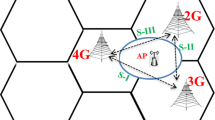Abstract
This paper proposes a Medium Access Control (MAC) protocol using directional antennas in wireless ad-hoc networks, which achieves frame-collision reduction, freezing-state duration reduction, and deafness-problem mitigation simultaneously. The idea of the proposed protocol is that Pulse/Tone exchange is applied to the Opportunistic Directional MAC protocol (OPDMAC). By applying the Pulse/Tone exchange prior to Request to Send/Clear to Send (RTS/CTS) handshake, RTS-to-RTS frame collisions are reduced dramatically. Additionally, RTS-to-DATA frame collisions in the OPDMAC are changed to Pulse signal-to-DATA frame overlaps in the proposed protocol. This change makes the DATA-frame transmissions in success because the Pulse signal-to-DATA frame overlaps are regarded as a deafness problem. On that basis, the deafness-problem mitigation can be obtained in the proposed protocol by adaptive transmission-direction switching, which follows the OPDMAC technique. The freezing-state durations can be also reduced by the transmission-direction switching. As a result, the proposed protocol provides high network throughput compared with conventional protocols. Simulation results show the validity and effectiveness of the proposed protocol.













Similar content being viewed by others
References
Bazan, O., & Jaseemuddin, M. (2012). A survey on MAC protocols for wireless adhoc networks with beamforming antennas. IEEE Communications Surveys & Tutorials, 14(2), 216–239.
Choudhury, R., Yang, X., Ramanathan, R., & Vaidya, N. (2002). Using directional antennas for medium access control in ad hoc networks. In Proceedings of the ACM MobiCom (pp. 59–70).
ElBatt, T., Anderson, T., & Ryu, B. (2003). Performance evaluation of multiple access protocols for ad hoc networks using directional antennas. In Proceedings of the IEEE WCNC (pp. 982–987).
Miura, K. & Bandai, M. (2012). Node architecture and MAC protocol for full duplex wireless and directional antennas. In Proceedings of the IEEE 23rd PIMRC (pp. 369–374).
Sugiyama, Y., Tamaki, K., Saruwatari, S., & Watanabe, T. (2014). A wireless full-duplex and multi-hop network with collision avoidance using directional antennas. In Proceedings of the IEEE ICMU (pp. 38–43).
Alam, Md N, Hussain, Md A, Md, A., & Kwak, K. S. (2013). Neighbor initiated approach for avoiding deaf and hidden node problems in directional MAC protocol for ad-hoc networks. Wireless Networks, 19(5), 933–943.
Abdullah, A. A., Cai, L., & Gebali, F. (2012). DSDMAC: dual sensing directional MAC protocol for ad hoc networks with directional antennas. IEEE Transactions on Vehicular Technology, 61(3), 1266–1275.
Niu, J., Zhang, R., Cai, L., & Yuan, J. (2015). A fully-distributed directional-to-directional MAC protocol for mobile ad hoc networks. In Proceedings of the ICNC (pp. 766–770).
Dholey, M. K., & Khatun, A. (2012). Reduction of blockage node and hidden terminal problem of CSMA/CA MAC protocol using directional antenna. In Proceedings of the IEEE PDGC (pp. 741–746).
Wang, G., Xiao, P., & Li, W. (2017). A novel MAC protocol for wireless network using multi-beam directional antennas. In Proceedings of the ICNC (pp. 36–40).
Bazan, O., & Jassemuddin, M. (2011). On the design of opportunistic MAC protocol for multihop wireless networks with beamforming antennas. IEEE Transactions on Mobile Computing, 10(3), 305–319.
Khatiwada, B., & Moh, S. (2015). A novel multi-channel MAC protocol for directional antennas in ad hoc networks. International Journal of Wireless Personal Communications, 80(3), 1095–1112.
Wang, P., & Petrova, M. (2016). A directional MAC scheme for enhancing frame aggregation in mm-wave wireless personal area networks. In Proceedings of the ICC (pp. 602–607).
Wang, Y., Motani, M., Garg, H. K., Chen, Q., & Luo, T. (2017). Cooperative multichannel directional medium access control for ad hoc networks. IEEE Systems Journal, 11(4), 1–12.
Nur, F. N., Sharmin, S., Razzaque, M. A., Islam, M. S., & Hassan, M. M. (2017). A low duty cycle MAC protocol for directional wireless sensor networks. International Journal of Wireless Personal Communications,. https://doi.org/10.1007/s11277-016-3728-4.
de Melo Guimaraes, L., & Bordim, J. L. (2013). Directional pulse/tone based channel reservation. In Proceedings of the AINA (pp. 276–283).
Xu, H., & Lei, L. (2016). A MAC protocol based on busy tone for ad-hoc networks with beamforming antennas. In Proceedings of the ICSAI (pp. 659–663).
Ma, J., Sekiya, H., Nagasaki, A., Komuro, N., & Sakata, S. (2012). MAC protocol for ad hoc networks using smart antennas for mitigating hidden and deafness problems. IEICE Transactions on Communications, E95–B(11), 3545–3555.
Ma, J., Sekiya, H., Komuro, N., & Sakata, S. (2012). MAC protocol for smart-antenna used ad hoc networks with RTS/CTS overhead reduction. Journal of Selected Areas in Telecommunications, 2(6), 10–19.
Dai, H. N., Ng, K. W., & Wu, M. Y. (2013). On busy-tone based MAC protocol for wireless networks with directional antennas. International Journal of Wireless Personal Communications, 73(3), 611–636.
Kosek-Szott, K., Natkaniec, M., & Pach, A. R. (2013). A new busy signal-based MAC protocol supporting QoS for ad-hoc networks with hidden nodes. Wireless Networks, 19(6), 1135–1153.
Choi, S. M., & Kim, S. (2017). Busy tone based multi-slot allocation protocol for improving performance in IEEE WLANs. In Proceedings of the ICOIN (pp. 426–428).
Roy, J., Siddik, M. A., Moni, S. S., & Alam M. S. (2016). An efficient cooperative MAC protocol for enhancing QoS of IEEE 802.11e EDCA in saturated conditions. In Proceedings of the ICECE (pp. 578–581).
Tobagi, F., & Kleinrock, L. (1975). Packet switching in radio channels: Part II: The hidden terminal problem in carrier sense multiple-access and the busy-tone solution. IEEE Transactions on Communications, 23(12), 1417–1433.
IEEE 802.11 Standard ParT II. (1999). Wireless LAN Medium Access Control (MAC) and Physical Layer (PHY) Specifications.
DMAC Simulator. http://www.s-lab.nd.chiba-u.jp/files/original_simulator_directional.zip.
Author information
Authors and Affiliations
Corresponding author
Additional information
Publisher's Note
Springer Nature remains neutral with regard to jurisdictional claims in published maps and institutional affiliations.
Rights and permissions
About this article
Cite this article
Okazawa, T., Ma, J., Komuro, N. et al. An Opportunistic Directional MAC Protocol with Pulse/Tone Exchange in Wireless Ad-Hoc Networks. Wireless Pers Commun 111, 1187–1205 (2020). https://doi.org/10.1007/s11277-019-06908-8
Published:
Issue Date:
DOI: https://doi.org/10.1007/s11277-019-06908-8




